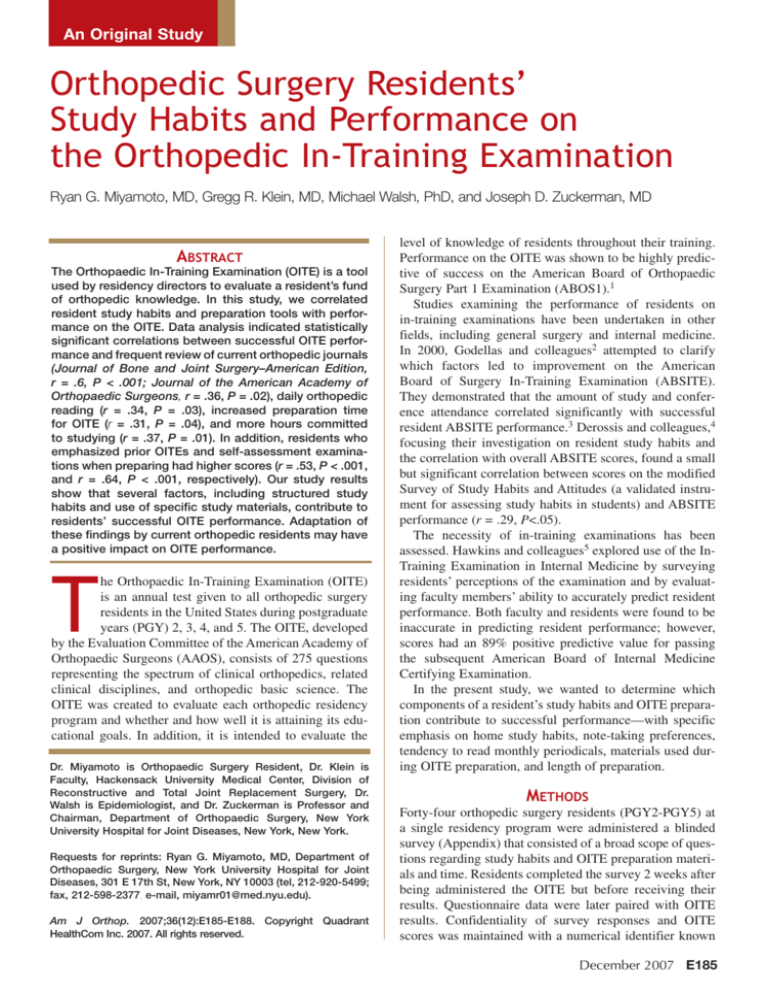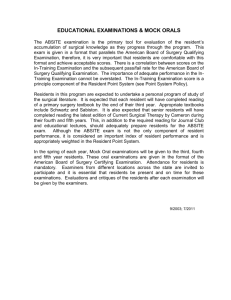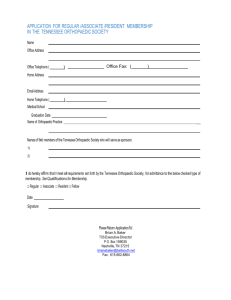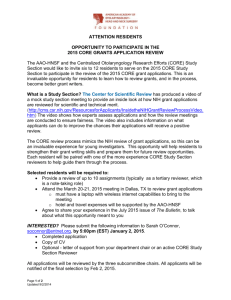
An Original Study
Orthopedic Surgery Residents’
Study Habits and Performance on
the Orthopedic In-Training Examination
Ryan G. Miyamoto, MD, Gregg R. Klein, MD, Michael Walsh, PhD, and Joseph D. Zuckerman, MD
Abstract
The Orthopaedic In-Training Examination (OITE) is a tool
used by residency directors to evaluate a resident’s fund
of orthopedic knowledge. In this study, we correlated
resident study habits and preparation tools with performance on the OITE. Data analysis indicated statistically
significant correlations between successful OITE performance and frequent review of current orthopedic journals
(Journal of Bone and Joint Surgery–American Edition,
r = .6, P < .001; Journal of the American Academy of
Orthopaedic Surgeons, r = .36, P = .02), daily orthopedic
reading (r = .34, P = .03), increased preparation time
for OITE (r = .31, P = .04), and more hours committed
to studying (r = .37, P = .01). In addition, residents who
emphasized prior OITEs and self-assessment examinations when preparing had higher scores (r = .53, P < .001,
and r = .64, P < .001, respectively). Our study results
show that several factors, including structured study
habits and use of specific study materials, contribute to
residents’ successful OITE performance. Adaptation of
these findings by current orthopedic residents may have
a positive impact on OITE performance.
T
he Orthopaedic In-Training Examination (OITE)
is an annual test given to all orthopedic surgery
residents in the United States during postgraduate
years (PGY) 2, 3, 4, and 5. The OITE, developed
by the Evaluation Committee of the American Academy of
Orthopaedic Surgeons (AAOS), consists of 275 questions
representing the spectrum of clinical orthopedics, related
clinical disciplines, and orthopedic basic science. The
OITE was created to evaluate each orthopedic residency
program and whether and how well it is attaining its educational goals. In addition, it is intended to evaluate the
Dr. Miyamoto is Orthopaedic Surgery Resident, Dr. Klein is
Faculty, Hackensack University Medical Center, Division of
Reconstructive and Total Joint Replacement Surgery, Dr.
Walsh is Epidemiologist, and Dr. Zuckerman is Professor and
Chairman, Department of Orthopaedic Surgery, New York
University Hospital for Joint Diseases, New York, New York.
Requests for reprints: Ryan G. Miyamoto, MD, Department of
Orthopaedic Surgery, New York University Hospital for Joint
Diseases, 301 E 17th St, New York, NY 10003 (tel, 212-920-5499;
fax, 212-598-2377; e-mail, miyamr01@med.nyu.edu).
Am J Orthop. 2007;36(12):E185-E188. Copyright Quadrant
HealthCom Inc. 2007. All rights reserved.
level of knowledge of residents throughout their training.
Performance on the OITE was shown to be highly predictive of success on the American Board of Orthopaedic
Surgery Part 1 Examination (ABOS1).1
Studies examining the performance of residents on
in-training examinations have been undertaken in other
fields, including general surgery and internal medicine.
In 2000, Godellas and colleagues2 attempted to clarify
which factors led to improvement on the American
Board of Surgery In-Training Examination (ABSITE).
They demonstrated that the amount of study and conference attendance correlated significantly with successful
resident ABSITE performance.3 Derossis and colleagues,4
focusing their investigation on resident study habits and
the correlation with overall ABSITE scores, found a small
but significant correlation between scores on the modified
Survey of Study Habits and Attitudes (a validated instrument for assessing study habits in students) and ABSITE
performance (r = .29, P<.05).
The necessity of in-training examinations has been
assessed. Hawkins and colleagues5 explored use of the InTraining Examination in Internal Medicine by surveying
residents’ perceptions of the examination and by evaluating faculty members’ ability to accurately predict resident
performance. Both faculty and residents were found to be
inaccurate in predicting resident performance; however,
scores had an 89% positive predictive value for passing
the subsequent American Board of Internal Medicine
Certifying Examination.
In the present study, we wanted to determine which
components of a resident’s study habits and OITE preparation contribute to successful performance—with specific
emphasis on home study habits, note-taking preferences,
tendency to read monthly periodicals, materials used during OITE preparation, and length of preparation.
Methods
Forty-four orthopedic surgery residents (PGY2-PGY5) at
a single residency program were administered a blinded
survey (Appendix) that consisted of a broad scope of questions regarding study habits and OITE preparation materials and time. Residents completed the survey 2 weeks after
being administered the OITE but before receiving their
results. Questionnaire data were later paired with OITE
results. Confidentiality of survey responses and OITE
scores was maintained with a numerical identifier known
December 2007 E185
Orthopedic Surgery Residents’ Study Habits
Table I. Assessed Factors and Their Association With Higher Orthopaedic
In-Training Examination (OITE) Scores
Factors Associated With Higher Scores
Factors Not Associated With Higher Scores
Self-review of topics outside formal lectures*
Routine review of Journal of Bone and Joint Surgery–American Edition*
Routine review of Journal of the American Academy of Orthopaedic Surgeons*
Increased examination preparation time*
Focused review of prior OITEs*
Focused review of self-assessment examinations*
Studying with other residents
Daily review/study of orthopedic material
Focused review of Orthopaedic Knowledge Update–General Knowledge
Focused review of Orthopaedic Knowledge Update–Specialty Series
*P<.05.
Note taking at protected lecture time*
Note taking while reading
Personal structured reading schedules
Reviewing lecture material before lecture
Focused review of textbooks
Focused review of review books (Miller’s Review)
Focused review of flashcards
Focused review of lecture notes
Focused review of online orthopedic Web sites
Focused review of review course material (Miller’s Review Course)
Table II. Assessed Factors and Their Use by Residents
Factor
No. of Residents
Reporting Use
Textbooks
Review books
Orthopaedic Knowledge Update–General Knowledge
Orthopaedic Knowledge Update–Specialty Series
Prior Orthopaedic In-Training Examinations Self-assessment examinations
Journal of Bone and Joint Surgery–American Edition and
Journal of the American Academy of Orthopaedic Surgeons
Flashcards
Lecture notes
Online orthopedic Web sites
Review course
34
44
17
14
43
23
only to the education coordinator responsible for recording
each resident’s OITE scores for our department.
OITE scores were correlated with study habits using the
Spearman correlation coefficient to assess the association
between the scores and specific habits during residents’
training.
Results
Higher OITE scores were associated with earlier start for
examination preparation (r = .31, P = .04) and higher total
number of hours devoted to studying (r = .37, P = .01). A
significant and strong correlation (r = .60, P < .001) was
identified between higher scores and monthly review of
the Journal of Bone and Joint Surgery–American Edition
(JBJS-A). A significant correlation (r = .36, P = .02) was
also identified between higher scores and frequent review
of the Journal of the American Academy of Orthopaedic
Surgeons (JAAOS). Residents who indicated that they
reviewed topics at home daily also tended to have higher
OITE scores (r = .34, P = .03) than residents who did not
review topics at home daily.
Regarding specific study materials, higher OITE scores
were found for residents who emphasized review of prior
OITEs (r = .53, P = .0052) and self-assessment examinations
(r = .64, P < .001). Although not statistically significant, a
positive correlation was found between high OITE scores
and 2 other study habits—routine review of topics other than
those presented at weekly conferences (P = .11) and studyE186 The American Journal of Orthopedics®
17
1
8
4
7
ing with other residents (P = .08). Residents who emphasized studying Orthopaedic Knowledge Update–General
Knowledge (r = .25, P = .09) and Orthopaedic Knowledge
Update–Specialty Series (r = .27, P = .08) also tended
to score higher, but statistical significance was also not
achieved. These results are summarized in Table I.
No correlation was found between OITE performance
and note taking during protected lecture time (P = .02) or
while reading (P = .32). In addition, significantly better
performance was not found for residents who had personal
structured reading schedules (P = .74) or who read lecture
material before lecture (P = .6).
Specific study materials that did not strongly correlate
with improved OITE performance included textbooks
(r = .08, P = .63), review books (r = .21, P = .17), self-constructed flashcards (r = .20, P = .20), lecture notes (r = .16,
P = .30), online orthopedic Web sites (r = .08, P = .61), and
review course material syllabi (r = .11, P = .46). See Table
I. The number of residents who reported using each form
of study material is displayed in Table II.
We reviewed the power required for all nonsignificant
comparisons in this study and found that, for all but one,
we would require a minimum sample size of 5604 residents
to achieve statistical significance for the observed relationships—indicating a true lack of association for these comparisons. The exception is the habit of studying with other
residents. Residents who studied with others scored almost
8.5 points higher than residents who studied alone. However,
R. G. Miyamoto et al
data were highly skewed, as only 4 residents reported
studying with others. We also used a nonparametric rank
sum test to test the difference, and the result was the same.
Nevertheless, we cannot rule out the possibility that the lack
of significance for this relationship may be a result of lack
of power, as a power analysis showed that only 22 residents
would be required to identify a significant relationship for
the observed mean difference and standard deviation.
Discussion
The importance of performing well on residency in-training examinations has been well documented in a variety of
medical and surgical specialties. The significance of success
on the OITE is well recognized by residency directors. A
correlation between OITE scores and successful completion
of the ABOS1 has been documented. The pass rate on the
ABOS1 is used by the Residency Review Committee during
program reviews; therefore, the effects of a program on OITE
performance can have an indirect impact on the accreditation process. On an individual level, OITE scores allow a
resident to assess command of his or her fund of orthopedic
knowledge. Although OITE and ABOS1 clearly cannot test a
resident’s surgical skills, the required passing of “the Boards”
for certification makes the importance of these cognitive
examinations much more tangible. In the present study, we
attempted to identify which study habits correlate with better
OITE performance and which study materials were useful in
achieving higher scores in our residency program.
Our results reinforce a basic tenet of modern medical
practice: Continued reading with preparation is important.
Monthly review of JBJS-A had a strong correlation with
OITE success, as did frequent review of JAAOS. It is
interesting that both journals had a positive correlation, as
their content is different. JBJS-A publishes peer-reviewed
manuscripts on basic and clinical research in musculoskeletal science, plus review articles in sections titled Current
Concepts, Instructional Course Lectures, and EvidenceBased Medicine. By comparison, JAAOS publishes articles
that, though also peer-reviewed, are broad overviews of topics of interest to their authors and may or may not be literature based in terms of factual coverage. Realistically, there
is likely great benefit in reviewing other orthopedic journals,
but JBJS-A and JAAOS are the only ones we assessed.
Reviewing topics months before taking the OITE and
dedicating a significant amount of time to OITE preparation can be challenging for most orthopedic residents. Busy
work schedules and other obligations can consume much of
a resident’s time. However, the importance of the OITE and
spending sufficient time in preparation should not be underemphasized. There is clearly a link between preparation time
and examination results. Daily reading and routine review of
topics other than those presented during protected lectures
are also likely to affect OITE performance. Undoubtedly,
the day-to-day learning that occurs while residents are performing their clinical responsibilities is an important source
of knowledge, but this specific factor could not be assessed
as a defined variable. Our study results suggest that spe-
cific emphasis on reviewing prior OITEs, self-assessment
examinations, and the Orthopaedic Knowledge Update may
enhance OITE performance, but not with the same degree of
significance as other factors identified.
The study materials assessed in our study but not linked
with higher OITE scores should not be interpreted as being
unhelpful. That some items (flashcards, online orthopedic
Web sites) were used by only a few residents in our program clearly affected statistical analysis. In addition, junior
residents are often influenced by advice and study materials “handed down” from more senior residents. These study
tools and tips on preparation are likely program-specific,
and surely there is variation among programs. Ultimately,
individual study patterns and comfort in using specific
materials determine how best to prepare for the OITE.
One study limitation is that our data were based on
responses from residents at a single orthopedic surgery
program (New York University Hospital for Joint Diseases).
Our program has 3 hours of structured didactic conferences per week, plus conferences on individual services.
Conference attendance is mandatory, and attendance is
recorded and monitored every week. Data gathered from
programs without dedicated lecture time may produce different results. It is unclear if the tools highlighted as improving OITE scores in our program would be the same as those
used in other programs. In addition, although our study
results were statistically significant, they were based on the
survey responses of only 44 residents, a relatively small
cross-section of residents currently training in the United
States. Furthermore, listing and assessing the impact of all
materials that are potentially useful in OITE preparation
were beyond the scope of our analysis.
It is difficult to say with any certainty that our results
would be consistent with those generated by a larger
sample of residents in a broader scope of programs. Our
goal was simply to identify which factors correlated with
higher OITE scores in our program and to give our residents a sense of which tools are “high yield” in studying
for the OITE.
Authors’ Disclosure Statement
The authors report no actual or potential conflict of interest
in relation to this article.
References
1. Klein GR, Austin MS, Randolph S, Sharkey PF, Hilibrand AS. Passing
the boards: can USMLE and Orthopaedic In-Training Examination scores
predict passage of the ABOS Part-I Examination? J Bone Joint Surg Am.
2004;86(5):1092-1095.
2. Godellas CV, Hauge LS, Huang R. Factors affecting improvement on the
American Board of Surgery In-Training Examination (ABSITE). J Surg Res.
2000;91(1):1-4.
3. Godellas CV, Huang R. Factors affecting performance on the American Board
of Surgery In-Training Examination. Am J Surg. 2001;181(4):294-296.
4. Derossis AM, DaRosa D, Schwartz A, Hauge LS, Bordage G. Study habits of
surgery residents and performance on American Board of Surgery In-Training
Examinations. Am J Surg. 2004;188(3):230-236.
5. Hawkins RE, Sumption KF, Gaglione MM, Holmboe ES. The In-Training
Examination in Internal Medicine: resident perceptions and lack of correlation between resident scores and faculty predictions of resident performance. Am J Med. 1999(2);106:206-210.
December 2007 E187
Orthopedic Surgery Residents’ Study Habits
Appendix. Survey questions asked of residents to assess their preparation for the Orthopaedic In-Training Examination (OITE).
1. Do you have didactic lectures?
YES NO If yes, how many hours per week?____
2. Do you have case conferences?
YES NO If yes, how many hours per week?____
3. Do you take notes during the protected lecture time at your program? YES NO
Do you study or review these notes? YES NO
4.Do you routinely review topics outside those
presented at your lectures? YES NO
5.Do you have a personal structured reading
schedule independent of lectures given at your program? YES NO
6. Do you read material regarding your lecture topics before lecture? YES NO
If yes, do you read:
The night before lecture? YES NO
In advance of the night before lecture? YES NO
7. Do you routinely take notes when you read?
YES NO
Do you review them when studying? YES NO
8. Do you study with other residents? YES NO
9. Do you routinely read:
Journal of Bone and Joint Surgery–
American Edition?
MONTHLY
EVERY OTHER MONTH
RARELY
NEVER
Journal of the American Academy of Orthopaedic Surgeons?
MONTHLY
EVERY OTHER MONTH
RARELY
NEVER
10. For the OITE administered last November, did
you use/review the following items?
(Rate their importance on a 1-to-5 scale: did not use [0], not helpful [1], moderately helpful [3], very helpful [5])
Textbooks as a source of review 0 1 2 3 4 5
Review books (eg, Miller’s Review) 0 1 2 3 4 5 Orthopaedic Knowledge Update–
General Knowledge
012345
Orthopaedic Knowledge Update–
Specialty Series
012345
Prior OITEs
012345
Self-assessment examinations
012345
Journal of Bone and Joint Surgery
–American Edition or
Journal of the American Academy of
Orthopaedic Surgeons 012345
Flashcards
012345
Lecture notes
012345
Online orthopedic Web sites
012345
Review course (Miller’s Review Course)
012345
Other materials______________
012345
11. How often do you read/study?
DAILY WEEKENDS
12. When did you start studying for the OITE?
<1 MONTH BEFORE
1 MONTH BEFORE
2-3 MONTHS BEFORE
>3 MONTHS BEFORE
13. How many total hours did you devote to studying?
<10 HOURS
10-20 HOURS
20-40 HOURS
40-60 HOURS
60-80 HOURS
>80 HOURS
14. Have you had more time to read since the 405 rules were implemented? YES NO
This paper will be judged for the Resident Writer’s Award.
E186 The American Journal of Orthopedics®
E188






